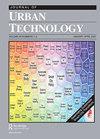利用大数据估算电动滑板车交通流量以支持微交通规划
IF 4.6
3区 经济学
Q1 URBAN STUDIES
引用次数: 22
摘要
无桩共享电动滑板车作为一种新型的共享微出行服务,近年来迅速普及。在本文中,我们提出了一种实用的方法,在不知道电动滑板车的实际路线的情况下估计电动滑板车的流量模式。我们的方法利用了一个巨大的开放数据集,其中包含数百万次旅行的起点和目的地。我们表明,我们的模型可以帮助城市更好地支持新兴的共享微型交通服务。建模过程中产生的附加信息也可以用于更精确地分析电动滑板车的行程。本文章由计算机程序翻译,如有差异,请以英文原文为准。
Estimating E-Scooter Traffic Flow Using Big Data to Support Planning for Micromobility
ABSTRACT Dockless e-scooter sharing, as a new shared micromobility service, has quickly gained popularity in recent years. In this paper, we present a practical approach to estimating e-scooter flow patterns without knowing the actual routes taken by the e-scooter riders. Our method takes advantage of a huge open dataset that contains the origins and destinations of millions of trips. We show that our models can help cities better support the emerging shared micromobility service. The additional information generated in the modeling process can also be useful for a more refined analysis of e-scooter trips.
求助全文
通过发布文献求助,成功后即可免费获取论文全文。
去求助
来源期刊

Journal of Urban Technology
URBAN STUDIES-
CiteScore
8.50
自引率
4.20%
发文量
42
期刊介绍:
The Journal of Urban Technology publishes articles that review and analyze developments in urban technologies as well as articles that study the history and the political, economic, environmental, social, esthetic, and ethical effects of those technologies. The goal of the journal is, through education and discussion, to maximize the positive and minimize the adverse effects of technology on cities. The journal"s mission is to open a conversation between specialists and non-specialists (or among practitioners of different specialities) and is designed for both scholars and a general audience whose businesses, occupations, professions, or studies require that they become aware of the effects of new technologies on urban environments.
 求助内容:
求助内容: 应助结果提醒方式:
应助结果提醒方式:


